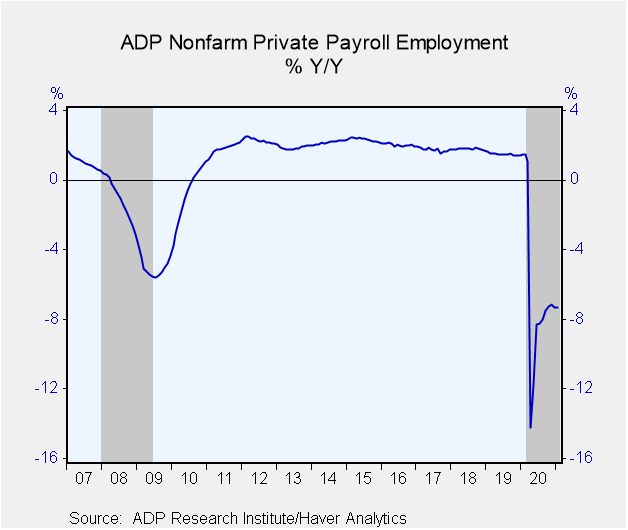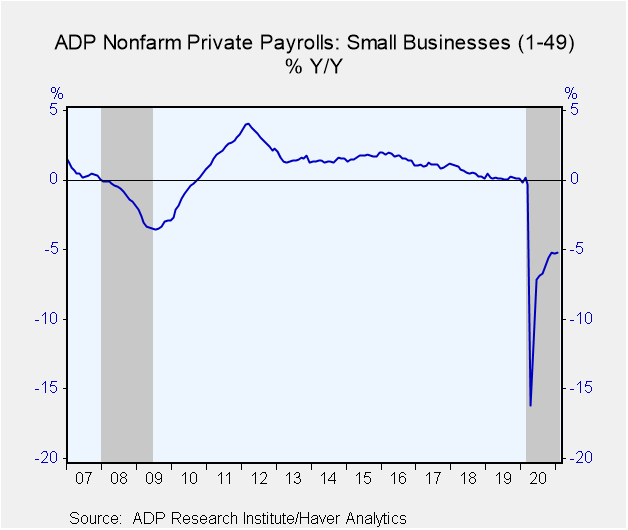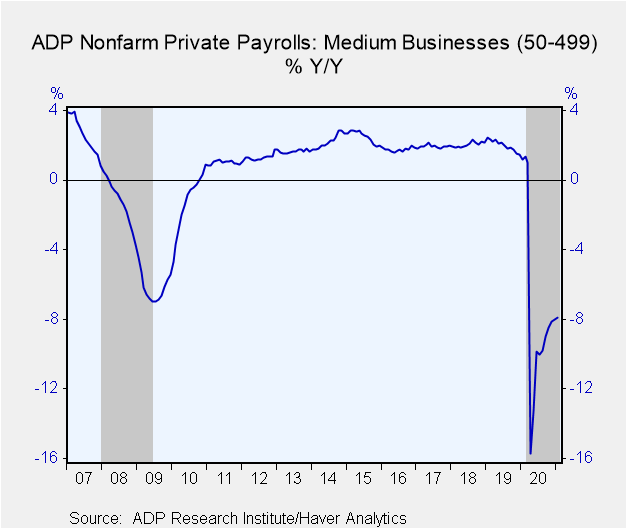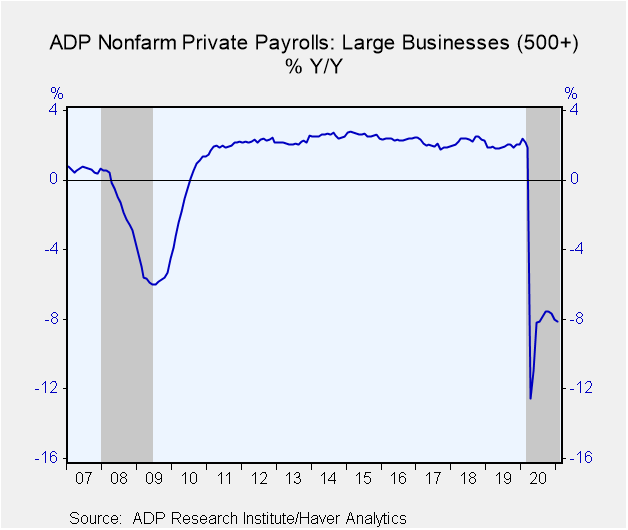 Global| Feb 03 2021
Global| Feb 03 2021U.S. ADP Nonfarm Private Payrolls Recover With Unexpected Strength in January
by:Tom Moeller
|in:Economy in Brief
Summary
• Job increase more-than-recoups December decline. • Broad-based sector gains are logged. • Medium-sized payrolls post strongest increase. Despite the COVID-19 epidemic and winter weather, the labor market improved last month. The ADP [...]
• Job increase more-than-recoups December decline.
• Broad-based sector gains are logged.
• Medium-sized payrolls post strongest increase.
Despite the COVID-19 epidemic and winter weather, the labor market improved last month. The ADP National Employment Report indicated that nonfarm private sector payrolls improved 174,000 (-7.3% y/y) during January following a 78,000 December decline, revised from -123,000. November's increase was revised to 299,000 from 304,000. A 63,000 January rise had been expected in the Action Economics Forecast Survey. The ADP report is based on survey data through January 12.
Large payrolls increased 39,000 (-8.1% y/y) last month following a 109,000 December decline, revised from -147,000. Small-sized payrolls increased 51,000 after falling 12,000 in December, revised from -13,000. Medium-sized payrolls rose 84,000 last month (-7.9% y/y) following a 43,000 gain, revised from 37,000.
Within industry sectors, private service employment increased 156,000 (-8.0% y/y) after a 73,000 December decline, revised from -105,000.The number of education & health services jobs rose 54,000 (-4.2% y/y) and have risen in each month since May. A 35,000 rise (-23.6% y/y) in leisure & hospitality hiring followed a 79,000 December loss. Jobs in trade, transportation & utilities rose 16,000 (-5.3% y/y) after falling 29,000 in December. A 40,000 rise (-5.9% y/y) in the number of professional business services jobs extended the sequential monthly job gain since May. Jobs in financial services edged 1,000 higher (-1.5% y/y) after increasing 3,000 during December. The number of information sector jobs eased 2,000 (-10.5% y/y), down for the third straight month.
Employment amongst goods-producing firms recovered 19,000 (-3.8% y/y) after falling 5,000 during December, revised from -18,000. The number of factory sector jobs edged 1,000 higher (-4.6% y/y) after falling 14,000 which was the first decline since April. The size of construction sector payrolls rose 18,000 (-1.8% y/y) following a 9,000 increase. Employment in the natural resource & mining sector held steady (-11.0% y/y) for the second consecutive month.
The Automatic Data Processing Research Institute survey covers 411,000 companies and includes about one-fifth of U.S. private payroll employment. The data are processed by Moody's Analytics Inc., then calibrated and aligned with the BLS establishment survey data. The ADP data cover private sector employment only.
The ADP National Employment Report data can be found in Haver's USECON database. Historical figures date back to 2001 for private employment and the industry breakdown, and 2005 for the business size breakout. The expectation figure is available in Haver's AS1REPNA database.
Can Government Spending Help to Escape Recessions? from the Federal Reserve Bank of San Francisco can be found here.
| ADP/Moody's National Employment Report | Jan | Dec | Nov | Jan Y/Y % | 2020 | 2019 | 2018 |
|---|---|---|---|---|---|---|---|
| Nonfarm Private Payroll Employment (m/m chg, 000s) | 174 | -78 | 299 | -7.3 | -6.3 | 1.5 | 1.8 |
| Small Payroll (1-49) | 51 | -12 | 107 | -5.2 | -5.9 | 0.2 | 0.6 |
| Medium Payroll (50-499) | 84 | 43 | 130 | -7.9 | -7.4 | 2.0 | 2.0 |
| Large Payroll (>500) | 39 | -109 | 62 | -8.1 | -6.0 | 1.9 | 2.3 |
| Goods-Producing | 19 | -5 | 30 | -3.8 | -4.0 | 1.6 | 2.9 |
| Construction | 18 | 9 | 21 | -1.8 | -2.3 | 2.7 | 4.1 |
| Manufacturing | 1 | -14 | 8 | -4.6 | -4.7 | 1.0 | 1.9 |
| Service-Producing | 156 | -73 | 269 | -8.0 | -6.8 | 1.5 | 1.6 |
Tom Moeller
AuthorMore in Author Profile »Prior to joining Haver Analytics in 2000, Mr. Moeller worked as the Economist at Chancellor Capital Management from 1985 to 1999. There, he developed comprehensive economic forecasts and interpreted economic data for equity and fixed income portfolio managers. Also at Chancellor, Mr. Moeller worked as an equity analyst and was responsible for researching and rating companies in the economically sensitive automobile and housing industries for investment in Chancellor’s equity portfolio. Prior to joining Chancellor, Mr. Moeller was an Economist at Citibank from 1979 to 1984. He also analyzed pricing behavior in the metals industry for the Council on Wage and Price Stability in Washington, D.C. In 1999, Mr. Moeller received the award for most accurate forecast from the Forecasters' Club of New York. From 1990 to 1992 he was President of the New York Association for Business Economists. Mr. Moeller earned an M.B.A. in Finance from Fordham University, where he graduated in 1987. He holds a Bachelor of Arts in Economics from George Washington University.










